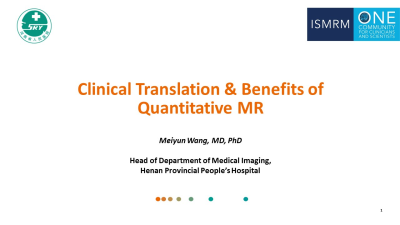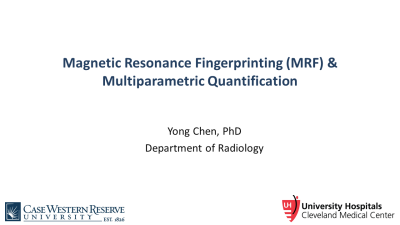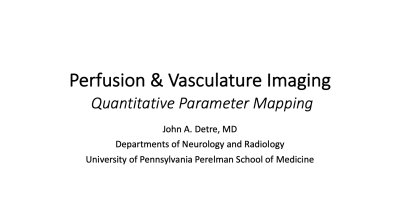Weekend Course
Quantitative Parameter Mapping
Joint Annual Meeting ISMRM-ESMRMB & ISMRT 31st Annual Meeting • 07-12 May 2022 • London, UK

| Quantitative MRI: What & Why? | |||
| 13:00 | A Technical Overview of Quantitative Imaging
Martijn Cloos
This talk reviews key principles of quantitative MRI. We will focus on methods to estimate longitudinal relaxation (T1), transverse relaxation (T2), and transmit field variations (B1+) in the brain. We will also briefly touch on other quantifiable properties, such as magnetisation transfer (MT), and discuss some of the limitations associated with model-based methods to quantitative properties of complex organic samples using MRI. Finally, we will briefly reflect on the trade-off between accuracy and precision, and its possible implications for future work. |
||
| 13:25 |  |
Clinical Translation & Benefits of Quantitative MR
Meiyun Wang
As an advanced MRI technique, Magnetic Resonance Fingerprinting (MRF) that allows simultaneous quantification of T1 and T2 relaxometry has great potential for accurate diagnosis and assessment of neurological diseases. In this presentation, we briefly introduce the application of the MRF on several neurological diseases in Henan Provincial People’s Hospital, including movement disorders, brain tumors and Epilepsy. The results turn out that quantitative T1 and T2 values yielded from MRF have high accuracy and repeatability in brain tissues and therefore provide better diagnose outcomes over conventional MRI, which gives rational evidence for further application of MRF.
|
|
| Quantifying Relaxation Parameters | |||
| 13:50 | Relaxometry Acquisition & Analysis Video Unavailable |
||
| 14:15 |  |
Magnetic Resonance Fingerprinting & Multiparametric Quantification
Yong Chen
Magnetic Resonance Fingerprinting (MRF) is a novel imaging technique for rapid and simultaneous quantification of multiple tissue properties. The method has been applied for quantitative imaging of many different organs. Compared to conventional quantitative MR imaging approaches, MRF has demonstrated superior performance in imaging speed, accuracy and efficiency. In this presentation, I will first provide a technical overview of the MRF method from data acquisition to post-processing. Recent development in advanced reconstruction methods, integration with machine learning, and application in clinical studies will also be reviewed.
|
|
| 14:40 | Break & Meet the Teachers |
||
| Beyond Relaxation: Quantifying Vascular Properties & Microstructure | |||
| 15:05 |  |
Perfusion & Vasculature Imaging
John Detre
Blood flow and tissue perfusion are fundamental physiological functions and disorders of blood flow and perfusion are major causes of medical morbidity and mortality. MRI methods provide noninvasive quantification of blood flow and perfusion in standard physiological units and have a broad range of applications in basic and clinical research. This presentation will briefly summarize key MRI methods for quantifying flow and tissue-specific perfusion and illustrate some of their applications as biomarkers in health and disease.
|
|
| 15:30 | Diffusion-Based Microstructure Quantification
Maryam Afzali
Diffusion MRI is a non-invasive technique to study tissue microstructure. Differences in the microstructural properties of tissue, including size and anisotropy, can be represented in the signal if the appropriate method of acquisition is used. Microstructural properties of the tissue at a micrometer scale can be linked to the diffusion signal at a millimeter-scale using biophysical modeling. However, to depict the underlying properties, special care must be taken when designing the acquisition protocol as any changes in the procedure might impact on quantitative measurements.
|
||
| Handling Motion: Techniques & Applications | |||
| 15:55 | Motion-Resolved Parameter Mapping
Nan Wang
Quantitative parametric MRI is a powerful tool for the characterization of tissues and management of diseases. In recent years, several motion-resolved parametric mapping techniques have been proposed, enabling the tissue quantification in heart, liver, and other moving organs. The motion states are characterized from the center k-space data or external recording. The reconstruction recovers multiple images at different motion states by exploiting the correlation along different dynamics.
|
||
| 16:20 | Translational Research in Pediatrics
Minhui Ouyang
The pediatric brain undergoes dramatic changes during development. Neuroimaging techniques, such as diffusion MRI and perfusion MRI, provide unprecedented opportunities to noninvasively quantify the brain changes in a pediatric population at both global and regional levels. These MRI methods offer a wealth of structural, functional, and physiological brain properties that could be used as biomarkers. This talk will briefly review the applications of diffusion and perfusion MRI technologies in brain development, as well as pediatric diseases and disorders such as autism, with protocols/pipelines tailored to pediatric populations.
|
||
The International Society for Magnetic Resonance in Medicine is accredited by the Accreditation Council for Continuing Medical Education to provide continuing medical education for physicians.